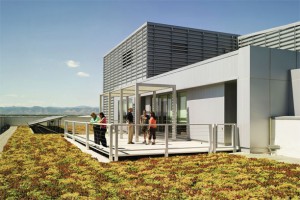The results are in…when it comes to the business case for sustainability, green buildings “walk the talk.”
In a recently issued white paper, GSA outlined the results of a post-occupancy evaluation study of 22 green federal buildings from across the country; the findings compared to national average commercial buildings:
- They cost less to maintain, by 19%
- They use less energy and water, by 25%
- They emit fewer carbon dioxide emissions, by 36% and
- They have more satisfied occupants, by 27%.
The study, conducted by the Pacific Northwest National Laboratory, built on a good indication of the potential for increased productivity and performance pilot research completed two years ago, with similarly impressive results.
For more than a decade, the federal government has declared its commitment to sustainable building though presidential directives and executive orders, congressional legislation and governmentwide policies. PBS began its sustainable design program in 1999, and they completed their first green roof in 1975.
There’s no question that focusing on sustainability is the right thing to do for our environment: commercial buildings account for 18% of the nation’s energy use. The numbers show that greening federal buildings in most cases makes good business sense, as well. By looking critically at real world performance, this report demonstrates that the GSA is very much on track to achieve its green building goals, and that GSA is delivering high-performance, sustainable workplaces federal agencies need to fulfill their missions on behalf of the American people.
Find out more by reading the white paper. BD+C
--
Related Stories
| Aug 11, 2010
PBK, DLR Group among nation's largest K-12 school design firms, according to BD+C's Giants 300 report
A ranking of the Top 75 K-12 School Design Firms based on Building Design+Construction's 2009 Giants 300 survey. For more Giants 300 rankings, visit http://www.BDCnetwork.com/Giants
| Aug 11, 2010
Turner Building Cost Index dips nearly 4% in second quarter 2009
Turner Construction Company announced that the second quarter 2009 Turner Building Cost Index, which measures nonresidential building construction costs in the U.S., has decreased 3.35% from the first quarter 2009 and is 8.92% lower than its peak in the second quarter of 2008. The Turner Building Cost Index number for second quarter 2009 is 837.
| Aug 11, 2010
AGC unveils comprehensive plan to revive the construction industry
The Associated General Contractors of America unveiled a new plan today designed to revive the nation’s construction industry. The plan, “Build Now for the Future: A Blueprint for Economic Growth,” is designed to reverse predictions that construction activity will continue to shrink through 2010, crippling broader economic growth.
| Aug 11, 2010
New AIA report on embassies: integrate security and design excellence
The American Institute of Architects (AIA) released a new report to help the State Department design and build 21st Century embassies.
| Aug 11, 2010
Section Eight Design wins 2009 Open Architecture Challenge for classroom design
Victor, Idaho-based Section Eight Design beat out seven other finalists to win the 2009 Open Architecture Challenge: Classroom, spearheaded by the Open Architecture Network. Section Eight partnered with Teton Valley Community School (TVCS) in Victor to design the classroom of the future. Currently based out of a remodeled house, students at Teton Valley Community School are now one step closer to getting a real classroom.







